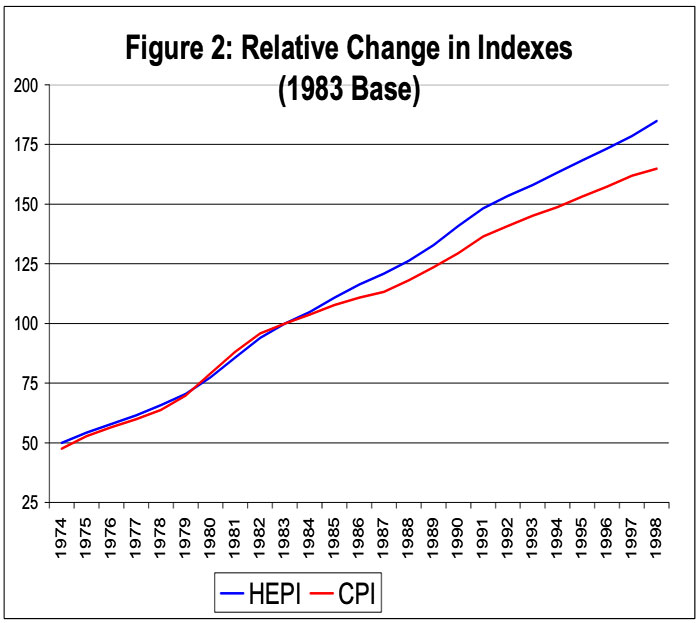Revenue Composition
The University of Missouri's general operating revenue comes from two primary sources, student fees and state appropriations. Together, these sources constitute nearly all (about 90%) of General Operating revenue. Over the past decade, the revenue proportions have changed dramatically with the University increasingly relying on student fees as state appropriations have represented a declining share.
- For the four University of Missouri campuses, state appropriations as a percent of total general operating revenue has declined over the ten-year period from FY1988-1998
 Table 1 (PDF 4 KB). The proportion of total general operating revenues coming from student fees has increased correspondingly, while Other Sources of revenue have remained relatively constant.
Table 1 (PDF 4 KB). The proportion of total general operating revenues coming from student fees has increased correspondingly, while Other Sources of revenue have remained relatively constant. - The decline in state appropriations as a percent of total general operating revenue on the four campuses are as follows: UMC, -11%; UMKC, -9%; UMR, -10%; and UMSL, -13%. The growth in the percent of total general operating revenues coming from student fees are: UMC, 9%; UMKC, 9%; UMR, 10%; and UMSL, 12%.
- Figure 1 shows the trends in the proportion of general operating revenues from student fees for the four campuses for FY1988 through FY1998:

- From FY1993-1997, through the five-year fee plan, the University increased fees above the rate of inflation in order to meet recurring expenditure obligations. Since then, inflation rates have been fairly low and the University's fee increases have also been low. As a result, continued reliance on student fee income to make up any shortfalls in state appropriations does not appear to be a practical alternative. Options which the University may want to consider include, but are not limited to, (1) evaluating alternate sources of general operating revenue to make up any potential shortfalls in state appropriations; (2) evaluating current general operating revenues and what they are used for (for example, the University may want to reevaluate those fees which are considered "dedicated" to particular activities or departments, in order to free up more fee revenue to be used for general operating purposes); or (3) instituting another policy of increasing student fees at a higher rate than inflation (however, given the marked increases in student fees during the Five-Year plan period from FY1993-1997, it is unlikely that the University can institute another fee plan which will increase fees at a higher rate than inflation in the near future).
 Table 2 shows the distribution of Unrestricted Educational and General (E&G) revenues for the four University of Missouri campuses and for the average of the public AAUDE institutions for the period FY1988-1997. The trends for the University of Missouri campuses are remarkably similar to that of the average of the AAUDE institutions; in all cases, state appropriations as a percent of unrestricted E&G revenues has declined, and the proportion of student fees has increased. However, for the AAUDE institutions, only two-thirds of the decline in state funds has been countered with an increase in the proportion of student fees, while the remainder has come from other sources. This is also true at UMC; state appropriations has declined 12% while student fees have increased approximately 7%, and other sources, 4%. For UMKC, UMR, and UMSL however, the reduction in the proportion of unrestricted E&G revenues coming from state appropriations has been offset almost totally through an increase in the proportion of student fees. UMKC and UMR show declines in the proportion of state appropriations of 12%, with an increase in the proportion of student fees of 11%. UMSL shows a similar trend, with state appropriations as a percent of E&G revenues declining 16%, and student fees increasing 15%. Since other public AAUDE institutions appear to be making up shortfalls in state appropriations in part through sources other than student fees, the University of Missouri should evaluate and attempt to capture the additional sources of income that these institutions are utilizing.
Table 2 shows the distribution of Unrestricted Educational and General (E&G) revenues for the four University of Missouri campuses and for the average of the public AAUDE institutions for the period FY1988-1997. The trends for the University of Missouri campuses are remarkably similar to that of the average of the AAUDE institutions; in all cases, state appropriations as a percent of unrestricted E&G revenues has declined, and the proportion of student fees has increased. However, for the AAUDE institutions, only two-thirds of the decline in state funds has been countered with an increase in the proportion of student fees, while the remainder has come from other sources. This is also true at UMC; state appropriations has declined 12% while student fees have increased approximately 7%, and other sources, 4%. For UMKC, UMR, and UMSL however, the reduction in the proportion of unrestricted E&G revenues coming from state appropriations has been offset almost totally through an increase in the proportion of student fees. UMKC and UMR show declines in the proportion of state appropriations of 12%, with an increase in the proportion of student fees of 11%. UMSL shows a similar trend, with state appropriations as a percent of E&G revenues declining 16%, and student fees increasing 15%. Since other public AAUDE institutions appear to be making up shortfalls in state appropriations in part through sources other than student fees, the University of Missouri should evaluate and attempt to capture the additional sources of income that these institutions are utilizing.
Reviewed 2025-08-18